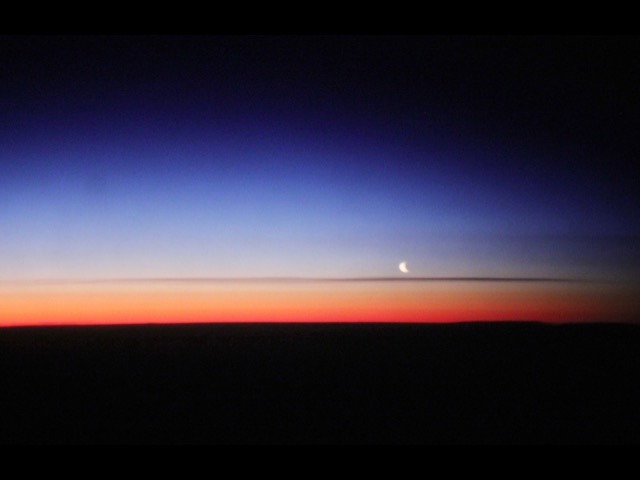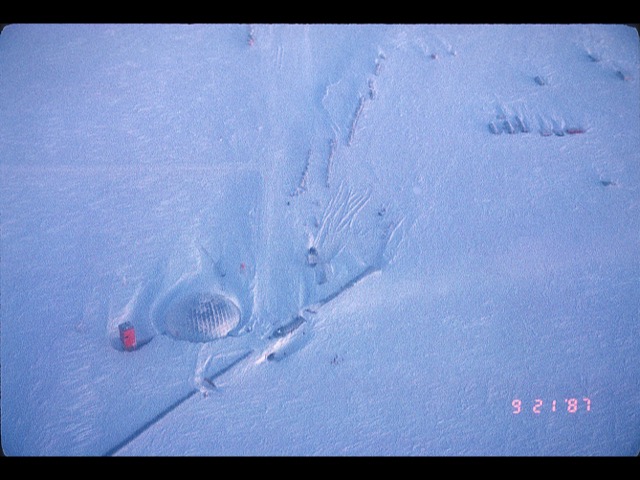Looking back on AAOE
By Brian Toon
17th August 2017
These days it is common to have field missions such as CRYSTAL-FACE, SEAC4RS or TC4 in which three or more aircraft not only launch together to study an atmospheric feature, but can be vectored to make common coordinated measurements of small scale phenomena such as single convective clouds. While missions still may need to have staff spread out, communications via satellites as well as cell phones and laptops allow groups to coordinate anywhere in the world, data to be brought down from aircraft, data analyses to be done in real time, instructions for flight plan alterations to be sent up to aircraft in flight, data assimilation models to make predictions for targeting specific phenomena, and satellite or ground based observations to be used to locate targets. Back in the day, though, these capabilities did not exist. The difficulty of launching the ER-2 in the harsh conditions in Punta Arenas and getting the newly outfitted DC-8 to takeoff led to no attempts at joint flights being made. Indeed, it was not until January 2000 during the SAGE III Ozone Loss and Validation Experiment (SOLVE) that the DC-8 and ER-2 began making coordinated flights, for instance over Russia. Fortunately, the polar vortex, and Antarctica are big targets. Aircraft flight plans for the DC-8, which had more flexibility and range than the ER-2, were based on the locations of the sun and moon for spectroscopic instruments, as well as avoiding or sampling clouds associated with predicted tropospheric weather systems. The DC-8 had in situ instruments that wanted to do vertical profiles, lidars that preferred level flights in the dark, and spectrometers that wished for level flight legs along very specific routes to see the sun or moon.
My job during AAOE was to serve as the Deputy Project Scientist, a somewhat frustrating job akin to being a vice president who can't communicate with the management. Usually I was the DC-8 flight scientist, so for most of the mission I was either flying on the DC-8 or in the hotel working with the navigator to plan the next flight. I had little time for meetings at the mission operations center in the hanger.

The DC-8 was a wonderful platform with an excellent instrument payload making high quality measurements of the large scale distributions of ozone, water vapor, chlorine species, nitrogen compounds, PSCs, and tracers that were essential to understanding the physics and chemistry behind the ozone hole and its set up over time. On many flights we flew for hours on end with Ed Browell's DIAL lidar revealing multiple thin layers of polar stratospheric clouds above the aircraft while a glance out the windows showed the same number of layers continuing into the distance as far as we could see. Below us a nearly featureless sheet of ice disappeared into the horizon.
Prior to AAOE Estelle Condon had those of us at NASA Ames practice our Spanish so that we could communicate in Chile. Meanwhile, the DC-8 crew had us practice using the aircraft escape slides. The DC-8 carried survival equipment – the heavy green parkas we were issued were very useful in Punta Arenas – and we learned how to make an igloo. Fortunately, the aircraft experienced no difficulties during flight; though there was one small thought-provoking case of an instrument's window-heater tape burning up. Fires are not good on airplanes. Often during flights we modified our flight plan to avoid heavy clouds. Since we were usually out of communication range during flights we might not have been found had we been forced to land on the ice. I appreciated the skill of the navigators in making changes to flight plans accurately so that we did not run out of fuel. On the final DC-8 flight of the mission from Punta Arenas, after the ER-2 had left taking the mission meteorologists with it, we attempted to fly from Punta Arenas over the South Pole to McMurdo and then on to New Zealand. Unfortunately, as we flew south we faced many hours of flight with 100 knot headwinds. Even falling off from the South Pole and McMurdo it still took an exciting 14 hours to reach New Zealand.

DC-8 flights were long, often 12 hours in length, so the aircraft carried a double crew of pilots. In order to get darkness for the lidars, a typical flight pattern involved arrival at the airfield by midnight or earlier for instruments that needed several hours of warm up, the 12 hour flight, and then a debrief. Repeated flights required stamina. One notable flight on September 21, near the spring equinox, included a descent to an altitude of a few hundred feet over the South Pole Station. We photographed the station, and the 18 people at the station photographed us. I still keep these photos on my office wall. From their enthusiastic waving I decided that the people at the South Pole Station were as happy to have us visit as to have the sun finally return to the Pole after the long winter. I was pleased that Bob Watson was on this flight to authorize the vertical profile. We circumnavigated the Earth at the South Pole. Later Arctic ozone loss missions led to similar visits to the North Pole, and to the formation of an informal DC-8 organization called the 90-90 club, for those who circumnavigated the Earth at both poles and were friends of both penguins and polar bears.
Punta Arenas at that time was not a hot spot for tourism; though rheas (a bird similar to an ostrich), and alpaca wandered freely around the local region lending it an exotic feel. Usually I found the women working in the local stores giggled at me like a visitor from outer space when I pointed at things I wanted to buy. My Spanish lessons did not pay off. Car travel was an adventure. The nearby highways were paved on one side, but gravel on the other. Consequently, everyone drove on the paved side and cresting the top of any hill was always a death-defying thrill. Most of the cars in Punta Arenas suffered severe damage from the gravel, even though many had heavy wire grills on the fronts. The cars inspired affection. Mark Schoeberl, a lifesaver to those of us without cars, named his the ER-zero. Local menus at the restaurants in Punta Arenas often seemed to be copied from the same source. There were exotic features on the menus such as Conger eel, which was tasty, and sea urchin pizza, which was not. The weekly event of Chinese food at one of the hotels was welcomed, and near riots occurred when it was canceled for a holiday. Pisco sours were the popular drink on days without flights, and I enjoyed the onion salads, which I wish I could find in the U.S. At that time the Pinochet government was in power in Chile. Our hotel faced a small central square. It seemed that every Friday night the park was the scene of demonstrations. Molotov cocktails were rumored to be thrown by some protestors. No damage was done and the debris was quickly cleaned up on Saturdays. On Sundays the military performed small parades. The locals soon learned that they could be human parking meters. They charged us to guard our parked cars near the hotel. Even after midnight in the cold and ever present wind, small children greeted us outside the hotel doors hoping for a handout as we rushed to the airport to prepare for a flight.
There were many novel aspects of AAOE. For example, after each flight the data were posted as graphs or pictures on walls and poster boards. This data display led to many exciting group discoveries and debates. It also led to one news reporter sneaking in to the data display room and then publishing a purloined photo of a microscopic image of a particle with a caption announcing that it was a picture of the ozone hole. AAOE was surrounded by secrecy that extended even to communications back home. I recall some groups trying to give hints of problems with instruments to their groups back home. Anyone present at AAOE must also recall the seemingly endless final meetings to draw up a mission summary. Under the able leadership of Dan Albritton and Bob Watson these meetings debated every one of the multitudes of sentences in the summary. The meetings were also notable for Adrian Tuck's unusual method of intense thought and concentration while seeming to be asleep leaning over in his chair. Sleep was a continual problem in AAOE, but Adrian became famous for his thinking/sleeping approach.
AAOE was a unique atmospheric scientific experiment in many ways. One important aspect was that prior to the mission a series of hypotheses were made about the cause of the ozone hole that could be answered with either a yes or a no. Such lack of ambiguity is rare in atmospheric science. One hypothesis for the ozone hole was that air was ascending over Antarctica and carrying low ozone air from the troposphere upward into the stratosphere. Tracer measurements on both aircraft showed this hypothesis was clearly wrong, and in fact tropospheric tracers were depleted in the ozone hole region where air was descending from higher altitudes. A second hypothesis was that solar activity was creating abundant nitrogen oxides at high altitude and these were descending into the lower stratosphere enhancing NOx catalysed loss of ozone. Data from both aircraft showed that nitrogen compounds were in fact depleted rather than enhanced. A third hypothesis, developed largely at the beginning of AAOE, was that the ozone hole was an observational artifact caused by tropospheric weather systems lifting the tropopause and dynamically depleting the ozone column as well as partly hiding it in clouds. Ozone mini-holes clearly existed and for several weeks early in the mission they seemed to be the only indication of ozone loss. For a while the atmospheric dynamicists seemed to me to be in ascendance, while the chemists slunk around apparently dejected. However, these mini-holes never covered a very large fraction of the vortex. Even the earliest flights of the ER-2 showed that ClO was enhanced in the vortex, while the earliest DC-8 flights indicated that chlorine reservoir species such as HCl and ClNO3 were depleted in the vortex relative to extra vortex air. However, ozone was not depleted in the earliest flights. Eventually ozone loss became evident as chemical destruction inexorably grew by a few percent per day. It became clear to all that ozone loss was not limited to mini-holes, but occurred throughout the polar vortex, where ozone and ClO were highly anti-correlated. The cause of the ozone loss was primarily chlorine containing compounds that were converted to forms that could catalytically destroy ozone within the vortex by reactions on the surfaces of polar stratospheric clouds that continued to be present during the ozone loss period.